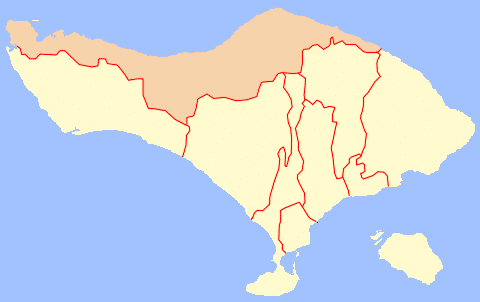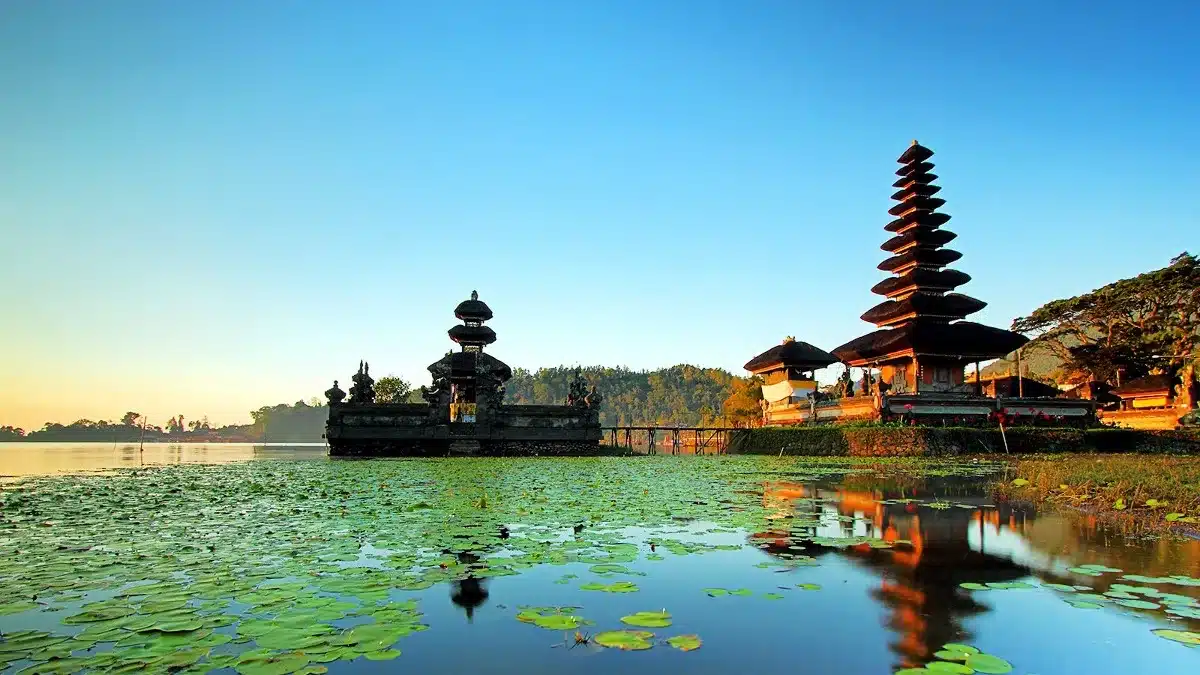Buleleng is a regency (kabupaten) on the Indonesian island of Bali. It has a total land area of 1,365.88 km2 and a population of 791,910, according to the 2020 census. Its regency seat is located in Singaraja.

Overview
Gusti Panji Sakti, who ruled from around 1660 to 1700, established Buleleng as a kingdom. He is remembered as a heroic ancestor figure who extended Buleleng’s dominion to Blambangan on East Java. During its successors, the kingdom was weakened and fell under the suzerainty of the nearby Karangasem kingdom in the second part of the 18th century. From 1806-1849, it was ruled by an autonomous branch of the Karangasem Dynasty.
Buleleng was attacked three times by the Dutch, and each time it was defeated.[5] Buleleng was absorbed into the Dutch colonial administration and lost its independence in 1882. The Dutch nominated a descendant of Gusti Panji Sakti, the renowned scholar Gusti Putu Jelantik, as regent in 1929. He died during the Japanese takeover of the Dutch East Indies in 1944. Anak Agung Nyoman Panji Tisna, his son, was a well-known novelist. Anak Agung Pandji Tisna abdicated the throne in 1947 and was succeeded by his younger brother, Anak Agung Ngurah Ketut Djelantik, known as Meester Djelantik, until 1950. Like the rest of Bali, Buleleng was included in Indonesia’s unitary republic in 1949-50.
Districts of Buleleng Regency
| Name | Area in km2 | Population census 2020 | Number of villages |
|---|---|---|---|
| Gerokgak | 356.57 | 97,552 | 14 |
| Seririt | 111.78 | 93,412 | 21 |
| Busungbiu | 196.62 | 52,690 | 15 |
| Banjar | 172.60 | 86,205 | 17 |
| Sukasada | 172.93 | 89,774 | 15 |
| Buleleng | 46.94 | 150,211 | 29 |
| Sawan | 92.52 | 80,174 | 14 |
| Kubutambahan | 118.24 | 68,778 | 13 |
| Tejakula | 97.68 | 73,017 | 10 |
| Totals | 1,365.88 | 791,813 | 148 |
Pearl Production
Many large pearl producers have created 130.9 hectares in Gerokgak village as a pearl breeding and producing region for world-class pearls. It will cover an area of 250 hectares, ranging from Gerokgak to Kubutambahan.
Things to do in Buleleng Regency
- Air Sanih: Located 18 kilometres east of Singaraja. A refreshing natural spring-fed pool surrounds the beach.
- Banjar Tegah Buddhist Monastery: In a picturesque valley setting, Banjar Tegah Buddhist Monastery is Bali’s largest Buddhist monastery.
- Banjar Tegah Hot Springs: Located 18 kilometres west of Singaraja, these sulfuric hot springs are highly recommended. Dragon fountains set slightly back in the hills spit hot water into the tiered bathing pools. A variety of souvenir shops and a restaurant caters to tourists. On weekends and holidays, a large number of locals and students visit.
- Banyuwedang: Located 60 kilometres west of Singaraja. Natural hot springs with purported medicinal properties are located near a temple.
- Buleleng Harbour: a historic but abandoned harbour on the north coast of Bali; this once-important harbour remains old warehouses, an antique pier, and an arched bridge. A memorial commemorating Bali’s effort to overcome the Dutch has been erected here.
- Deer Island (Pulau Menjangan): Located 79 km west of Sinagraja is one of the world’s most famous marine parks and part of the West Bali National Park. This small island is home to rare and protected Java Deer, but people come for diving and snorkelling.
- Dolphin Tour: Depart at approximately 06.00 a.m. aboard a traditional boat (for a nominal fee) from the Lovina Beach area, arranged by the local fishing community. It takes about two and a half hours to return. Those in the Kuta region must depart at 3.00 a.m. to travel to Lovina Beach or at 04.00 a.m. from the Ubud area. Alternatively, staying one night or more at Lovina Beach before embarking on a dolphin excursion may be preferable.
- Gitgit Waterfall: Located 11 kilometres south of Singaraja in a coffee and clove plantation, a fantastic waterfall pours into a little lagoon.
- Gondol: Situated 50 kilometres west of Singaraja. A fish breeding initiative run by the government. The programme includes turtles, shrimp, and prawns.
- Jagaraga: located 13 kilometres southeast of Singaraja, is another northern temple with funny carvings, some of which portray drunken Dutch colonialists, an armed heist, and a WWII dogfight between aeroplanes.
- Julah: situated kilometres east of Singaraja, is said to be the oldest village in North Bali.
- Kubutambahan: Located 12 kilometres east of Singaraja. The Maduwe Karang Temple is well-known for its innovative carvings. One such carving depicts a Dutch colonialist riding a bicycle with tyres made entirely of petals!
- Labuhan Lalang: A small port from which divers and visitors can board a boat to Deer Island (Menjangan Island), a small island with a serene and tranquil ambience due to the lack of a population.
- Lovina: Located 10 kilometres west of Singaraja, it is the primary tourist location in Buleleng. Palm-fringed black sand beaches open onto a calm sea where visitors can see dolphins, snorkel, dive, sail, fish, and swim.
- Munduk: Bali’s ecological village, located southwest of Singaraja. This picturesque mountain village is a perfect spot to stay to escape the heat. Its foggy mornings, fields of blue hydrangeas, and several waterfalls make it an excellent hiking destination.
- Pancasari: Situated 24 kilometres south of Singaraja. The Bali Handara Kosaido Country Club and two of Bali’s lakes, Buyan and Tamblingan, are in this highland settlement.
- Ponjok Batu: Located 25 kilometres east of Singaraja. The Ponjok Batu Temple (ponjok batu means “stone pile”) is perched on a steep cliff near a beach. A freshwater spring springs up straight on the beach.
- Pulaki Temple: Located 53 kilometres west of Singaraja is a big temple on both sides of the road, one perched on a rocky rock looking out to sea, the other climbing into the hills, housing monkeys who eat virtually anything in sight! Balinese women sell fruit to tourists, and grapes are their favourite.
- Pura Agung Jagatnatha: One of Bali’s most prominent and newest temples; a notable feature is the Padmasana, a shrine that symbolises the three elements of the Balinese Universe.
- Pura Dalem: The temple of the ancestors is well-known for its unusual and humorous stone carvings. Pura Beji, a temple devoted to the Goddess of Rice, also receives these exceptional carvings.
- Sangsit: Located 8 kilometres east of Singaraja.
- Sawan: Located 16 kilometres southeast of Singaraja is known for its traditional makers of gamelan gongs and other gamelan instruments. The Batu Bolong temple has a striking appearance.
- Sembiran: Situated 30 kilometres southeast of Singaraja, the culture, accent, and traditions significantly differ from the rest of Bali, and it is most likely a megalithic village.
- Sing Sing Waterfall: Located 13 kilometres west of Singaraja. In the dry season, the water may not flow as quickly as during the wet season. However, the falls are adequately marked.
- Singa Ambara Raja: The winged-lion statue on Jl Veteran, near the Tourist Office and opposite the office of the Governor of Buleleng, symbolises the heroic spirit of the people of Buleleng.
- Singaraja: During the Dutch colonial era, foreign traders heavily influenced this town. Singaraja is home to several Chinese temples and colonial structures. The Gedong Kertya Library has a one-of-a-kind collection of Lontar (palm leaf) texts written in Balinese that span a wide range of topics, such as traditional literature, medicinal prescriptions, black magic, and much more. Many old books are available in English, Dutch, and Ancient Javanese (Kawi).
- Teluk Terima: Located 76 kilometres west of Singaraja, also known as Jayaprana’s burial, this memorial commemorates the tragic love story of a prince who wanted to marry a rural girl, but the monarch also wanted to marry the girl and had the prince assassinated. Dreaming of the events, the girl committed suicide rather than marry the evil king. A panoramic view to the north makes this a must-see location.
- Temukus War Monument: During the Balinese independence fight, the Dutch built and the Balinese destroyed it. The local government rebuilt it in 1992. The monument provides an excellent perspective of Lovina and the coastline. The monument is located 15 kilometres from Singaraja.
- West Bali National Park: This park is home to the endangered Java Deer, the even more endangered Bali Starling, and various other creatures, including the Boss Javanicus, or wild bull.
Buleleleng Regency Location
Buleleng Regency FAQs
Buleleng Regency is a regency (administrative region) of Bali, Indonesia. It is located in the northern part of the island and is known for its diverse landscapes, which include mountains, beaches, and coral reefs.
Buleleng Regency is situated on the northern coast of Bali Island. It spans from the central part of the island to its northern coast, encompassing both coastal and inland areas.
The capital of Buleleng Regency is Singaraja. This city was historically the main port and administrative centre during Dutch colonial rule in Bali and retains a blend of Balinese and colonial architecture.
Main attractions in Buleleng include:
Lovina Beach: Famous for dolphin-watching tours and snorkelling.
Sekumpul Waterfall: Known as the most beautiful waterfall in Bali.
Gitgit Waterfall: A popular spot for hiking and picnics.
Pemuteran Beach: Known for its bio-rock coral reefs conservation project.
Menjangan Island: Part of the West Bali National Park, famous for diving and snorkelling.
Tourists can enjoy various activities such as:
Dolphin watching at Lovina Beach.
Snorkeling and diving around Menjangan Island and Pemuteran Beach.
Hiking to waterfalls like Sekumpul and Gitgit.
Exploring the heritage of Singaraja, which includes colonial buildings and the Gedong Kirtya library.
Buleleng Regency can be reached by car or bus from Bali’s capital, Denpasar. The drive north offers scenic views and passes through several Balinese villages. The nearest airport is Ngurah Rai International Airport, located in Denpasar.
The best time to visit Buleleng Regency is during the dry season from April to September. This period offers sunny days that are ideal for outdoor activities and exploring the beaches.
Yes, there are several cultural sites in Buleleng, including:
Beji Temple: An important temple for the Subak (irrigation system) culture, dedicated to Dewi Sri, the goddess of rice.
Gedong Kirtya Museum: Home to ancient lontar (palm leaf) manuscripts, showcasing Balinese culture and history.
Accommodation options in Buleleng range from guesthouses and homestays to luxury resorts, especially around Lovina Beach and Pemuteran. Many offer views of the sea or are close to the beach.
Visitors to Buleleng can try local Balinese cuisine, which includes dishes like:
Nasi Campur Bali: A mixed rice dish served with small portions of vegetables, fish, and meat.
Satay Lilit: Balinese satay, made from minced meat mixed with grated coconut, coconut milk, lime leaves, and other spices.

